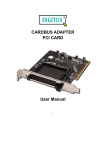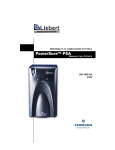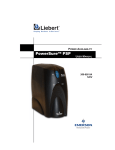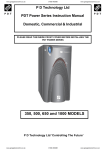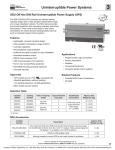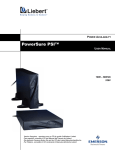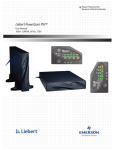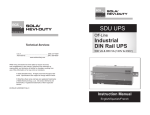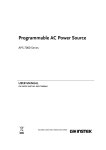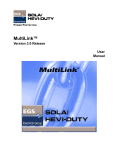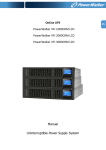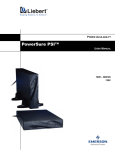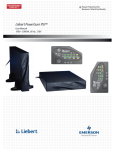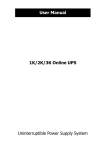Download datasheet: pdf
Transcript
S2K UPS USER MANUAL Line-Interactive 350-1000 VA 230V TABLE OF CONTENTS IMPORTANT SAFETY INSTRUCTIONS . . . . . . . . . . . . . . . . . . . . . 1 INTRODUCTION & SYSTEM DESCRIPTION . . . . . . . . . . . . . . . . . 5 Front View of UPS . . . . . . . . . . . . . . . . . . . . . . . . . . . . . . . . . . . . 6 Rear View of UPS. . . . . . . . . . . . . . . . . . . . . . . . . . . . . . . . . . . . . 7 MAJOR COMPONENTS . . . . . . . . . . . . . . . . . . . . . . . . . . . . . . . 8 Transient Voltage Surge Suppression (TVSS) & EMI/RFI Filters . . . . . . . . . . . . . . . . . . . . . . . . . . . . . . . . . . . . . . . . . . . . . . 8 Automatic Voltage Regulator . . . . . . . . . . . . . . . . . . . . . . . . . . . 8 Bi-Directional Converter . . . . . . . . . . . . . . . . . . . . . . . . . . . . . . . 8 Battery . . . . . . . . . . . . . . . . . . . . . . . . . . . . . . . . . . . . . . . . . . . . . 8 WHAT’S INCLUDED . . . . . . . . . . . . . . . . . . . . . . . . . . . . . . . . . 9 INSTALLATION. . . . . . . . . . . . . . . . . . . . . . . . . . . . . . . . . . . . 10 CONTROLS AND INDICATORS . . . . . . . . . . . . . . . . . . . . . . . . . 12 ON/OFF/Alarm Silence Button . . . . . . . . . . . . . . . . . . . . . . . . 12 Status Indicators: Mains, Battery, Fault . . . . . . . . . . . . . . . . . 13 Mains Indicator (Green/Amber) . . . . . . . . . . . . . . . . . . . . . . . . . . 13 Battery Indicator (Green/Amber) . . . . . . . . . . . . . . . . . . . . . . . . . 13 Fault Indicator (Red/Green) . . . . . . . . . . . . . . . . . . . . . . . . . . . . . 13 Location and Status of Indicators . . . . . . . . . . . . . . . . . . . . . . . . . 13 Transfer Voltage Selectors (DIP Switches) . . . . . . . . . . . . . . . 14 MODES OF OPERATION . . . . . . . . . . . . . . . . . . . . . . . . . . . . . 15 Normal Mode . . . . . . . . . . . . . . . . . . . . . . . . . . . . . . . . . . . . . . . 15 Buck/Boost Mode . . . . . . . . . . . . . . . . . . . . . . . . . . . . . . . . . . . . 15 Battery Mode . . . . . . . . . . . . . . . . . . . . . . . . . . . . . . . . . . . . . . . 16 COMMUNICATIONS . . . . . . . . . . . . . . . . . . . . . . . . . . . . . . . . 17 DB-9 Connector . . . . . . . . . . . . . . . . . . . . . . . . . . . . . . . . . . . . . 17 Remote Shutdown Via the DB-9 Connector . . . . . . . . . . . . . . . 18 Shutdown Via Pins 5 & 6 . . . . . . . . . . . . . . . . . . . . . . . . . . . . . . . . 18 Shutdown Via Pins 4 & 5 . . . . . . . . . . . . . . . . . . . . . . . . . . . . . . . . 18 USB Interface Port. . . . . . . . . . . . . . . . . . . . . . . . . . . . . . . . . . . 18 Data Line Protection Connectors . . . . . . . . . . . . . . . . . . . . . . . 18 i MAINTENANCE . . . . . . . . . . . . . . . . . . . . . . . . . . . . . . . . . . . 19 Cleaning the UPS. . . . . . . . . . . . . . . . . . . . . . . . . . . . . . . . . . . . 19 Maintaining Batteries . . . . . . . . . . . . . . . . . . . . . . . . . . . . . . . . 19 Battery Replacement . . . . . . . . . . . . . . . . . . . . . . . . . . . . . . . . . 19 Battery Replacement Procedure . . . . . . . . . . . . . . . . . . . . . . . . . . 20 TROUBLESHOOTING . . . . . . . . . . . . . . . . . . . . . . . . . . . . . . . 21 Guide to Status Indicators. . . . . . . . . . . . . . . . . . . . . . . . . . . . . 21 Troubleshooting Chart . . . . . . . . . . . . . . . . . . . . . . . . . . . . . . . . 22 SPECIFICATIONS . . . . . . . . . . . . . . . . . . . . . . . . . . . . . . . . . 23 Battery Run Times. . . . . . . . . . . . . . . . . . . . . . . . . . . . . . . . . . . 24 Product Warranty Registration. . . . . . . . . . . . . . . . . . . . . . . . . 25 ii IMPORTANT SAFETY INSTRUCTIONS SAVE THESE INSTRUCTIONS This manual contains important safety instructions that should be followed during the installation and maintenance of the Uninterruptible Power System (UPS) and its batteries. Please read this manual thoroughly before attempting to install or operate this UPS. Read all safety, installation, and operating instructions before operating the UPS. Adhere to all warnings on the unit and in this manual. Follow all operating and user instructions. This equipment is designed for Commercial, Industrial or Residential use. Sola/Hevi-Duty neither recommends nor knowingly sells this product for use in life support applications or with other designated critical devices. This equipment can be installed and operated by individuals without previous training. ! WARNING SAFETY PRECAUTIONS • There are no user-serviceable parts inside this UPS except the internal battery pack. Refer all UPS service to qualified service personnel. Do not attempt to service this product yourself. • Output receptacles on the UPS are electrically live if the UPS is switched on, even if the UPS is not plugged into a Mains supply. The ON/OFF button on the UPS does not electrically isolate the internal parts. Some components are live even when Mains power is disconnected. To isolate the UPS, switch off the UPS first, then unplug it from the Mains. • Opening or removing the cover may expose you to lethal voltages within this unit even when it is apparently not operating and the input wiring is disconnected from the electrical source. • Observe all CAUTION and WARNING statements in this manual and on the unit. Failure to do so may result in serious injury or death. • Never work alone. 1 ! ! WARNING ELECTRICAL PRECAUTIONS • This UPS should not be supplied from electrical power systems of the “IT” (Impedance á Terre) type (IEC 364 - Electrical Installation of Buildings). • The UPS must be earthed/grounded at all times during operation. Connect only to a mains supply socket outlet with an earth/ground connection. CAUTION Although your UPS has been designed and manufactured to assure personal safety, improper use may result in electrical shock or fire. To ensure safety, please observe the following rules: • Turn off and unplug your UPS before cleaning. Do not use liquid or aerosol cleaners. A dry cloth is recommended to remove dust from the surface of your UPS. • Do not install or operate your UPS in or near water. • Do not place your UPS on an unstable cart, stand or table. • Do not place your UPS in direct sunlight or near heat emitting sources. • Never block or insert any objects into the ventilation holes or other openings of the UPS. Keep all vents free of dust accumulation that could restrict airflow. • Do not place the UPS power cord in any area where it may be damaged by heavy objects. • Placing magnetic storage on the top of the UPS may result in data corruption. 2 ! ! CAUTION BATTERY HANDLING PRECAUTIONS Servicing of batteries should be performed or supervised by personnel knowledgeable of batteries and required precautions. Keep unauthorized personnel away from the batteries. A battery can present a risk of electrical shock and high short-circuit current. The following precautions should be observed when working on batteries: • Remove watches, rings, and other metal objects. • Use tools with insulated handles. • Do not dispose battery or batteries in a fire. The battery may explode. • Do not open or mutilate the battery or batteries. Released electrolyte is harmful to skin and eyes. It may be toxic. • When replacing the battery, use same number and type of battery as the suitable recommended type of battery listed in specification table in back of this manual. • Handle, transport and recycle batteries in accordance with local regulations. WARNING If your UPS demonstrates any of the following conditions, turn off and unplug your UPS from the outlet and contact your local distributor, Sola/Hevi-Duty representative, or Sola/Hevi-Duty Technical Services. • The power cord is damaged. • Liquid has been spilled on the UPS. • The circuit breaker or fuse opens frequently. • The UPS does not operate in accordance with the user manual. 3 Electromagnetic Compatibility—The Sola S2K series complies with the requirements of the EMC Directive 89/336/EEC and the published technical standards. Continued compliance requires installation in accordance with these instructions and use of Sola/Hevi-Duty approved accessories only. Environmental—Operate the UPS in an indoor environment only in an ambient temperature range of 0°C to 40°C (32°F to 104°F). Install in a clean environment, free from conductive contaminates, moisture, flammable liquids, gases, or corrosive substances. Provided are a MultiLink cable and a USB cable for connection to a computer. Do not use the MultiLink cable for other applications. Store in a safe place if not required at this time. When using the communication features on this UPS, ensure the cabling connected to the DB-9 or UPS communications ports are kept separated from the power leads to the UPS input and output. 4 INTRODUCTION & SYSTEM DESCRIPTION Congratulations on your choice of the Sola S2K series Uninterruptible Power System (UPS). It provides filtered AC power to sensitive electronic equipment and other critical loads. The S2K unit is a line-interactive UPS designed for an office environment. It provides perfect power protection for PCs, point-of-sale systems, network and similar electronic equipment. It offers a configurable input voltage window allowing you to precisely match your equipment’s input power. Three communications options are available: serial connection, contact closure and USB. The S2K unit is available in four (4) sizes: 350, 500, 650 and 1000VA at 120 VAC and 230 VAC. Sola S2K models are available for 120 VAC and 230 VAC supply voltages and loads. Please verify that this model matches your AC Mains and load voltage requirements. 5 Front View of UPS Power ON/OFF/ Alarm Silence* Mains Indicator* (Green/Amber) Fault Indicator* (Red/Green) Battery Indicator* (Green/Amber) * For details, see Controls and Indicators section 6 Rear View of UPS 350&500VA Models DIP switches** USB port*** Data Line Protection Connectors (2)*** DB-9 port*** Phone/Fax/DSL/Internet/ Modem devices Black output receptacles (2)* Orange output receptacles* Surge protection only Battery backup + surge protection AC input Input circuit protector Battery cover plate (on rear of 350 & 500VA models) 650 &1000 VA Models DIP switches** USB port*** DB-9 port*** Data Line Protection Connectors (2)*** Orange output receptacles* Phone/Fax/DSL/Internet/ Modem devices Battery backup + surge protection Black output receptacles (2)* Surge protection only NOTE: Bottom two receptacles on 1000VA models only Input circuit protector AC input Battery cover plate (bottom of unit for 650 & 1000VA models) For details, see: * Installation section ** Controls and Indicators section *** Communications section 7 MAJOR COMPONENTS Input L TVSS & EMI/RFI Filters Automatic Voltage Regulator Output L Bi-Directional Converter Battery N N G G Transient Voltage Surge Suppression (TVSS) & EMI/RFI Filters These UPS components provide surge protection and filter electromagnetic interference (EMI) and radio frequency interference (RFI). They minimize surges or interference present in the mains line and keep the sensitive equipment protected. Automatic Voltage Regulator The Automatic Voltage Regulator (AVR) protects connected equipment from power spikes and other abnormalities by raising an undervoltage (boost) and lowering an overvoltage (buck) as needed. This keeps the UPS output voltage within the connected equipment’s tolerance and accommodates wide mains voltage fluctuations without utilizing the batteries. Bi-Directional Converter In normal operation, the Bi-Directional Converter changes mains AC power into regulated DC power to “float charge” the battery system. This converter is continuously charging the battery whenever the UPS is plugged into a power outlet and mains power is within acceptable limits—even if the UPS is turned OFF. When mains power fails, the Bi-Directional Converter draws energy from the battery and inverts it into a regulated stepped sinewave supplying power for equipment connected to the orange receptacles. Battery The S2K unit utilizes valve-regulated, nonspillable, lead acid batteries. To optimize battery life, operate the UPS in an ambient temperature of 20°-25°C (68°-77°F). 8 WHAT’S INCLUDED The S2K unit is shipped with the following items: • Sola S2K user manual • MultiLink™ software CD • MultiLink serial cable, 3.0m (10 ft.) • USB cable, 1.8m (6 ft.) • RJ-11 cord, 2.1m (7 ft.) • Two (2) 10A output power cords, 2.0m (6.6 ft.) Sola S2K Unit USB cable 1.8m (6 ft.) MultiLink software CD RJ-11 cord 2.1m (7 ft.) 9 MultiLink serial cable 3.0m (10 ft.) Two (2) 10A output power cords, 2.0m (6.6 ft.) INSTALLATION This UPS is designed for data processing equipment. Maximum load must not exceed that shown on the UPS rating label. Do not connect equipment that could overload the UPS or draw half-wave current from the UPS, for example: electric drills, vacuum cleaners, laser printers or hair dryers. Your total load earth leakage current must not exceed 3.5 mA. Most data processing equipment meets this requirement if you use no more than two pieces of equipment. If uncertain about your load, consult your local distributor, Sola/Hevi-Duty representative, or Sola/Hevi-Duty Technical Services. 1. Visually inspect the UPS for freight damage. Report damage to the carrier and your local distributor, Sola/Hevi-Duty representative, or Sola/Hevi-Duty Technical Services. 2. Decide where to place the S2K unit. Find a location that is near an easily accessible mains outlet. Install the UPS indoors in a controlled environment, where it cannot be accidentally turned off. Place it in an area of unrestricted airflow around the unit, away from water, flammable liquids, gases, corrosives, and conductive contaminants. Maintain a minimum clearance of 100mm (4 inches) on each side of the UPS. Maintain an ambient temperature range of 0°C to 40°C (32°F to 104°F). NOTE UPS operation in temperatures above 25°C (77°F) reduces battery life. Plug computers, monitors & network hubs into orange receptacles Plug this type of equipment into black receptacles ONLY Inkjet printer Scanner Fax machine 3. The Sola S2K 230 VAC models are not supplied with an input power lead for connection to the mains supply. Additional input/output leads can be obtained from your dealer. The input power cord must have a minimal cross-sectional area of 1mm2. 10 4. Shut down the load equipment and turn off the mains supply. Unplug the load equipment’s power input cable from the mains supply socket and plug it into the UPS input socket. Plug the power input cable into the mains supply socket. Connect the supplied IEC-320-C14 output power cable between the load equipment input socket and one of the UPS AC output sockets. Connect all load equipment to the UPS in this manner. 5. Plug any computers and monitors into the orange battery backed up receptacles. Other office machines that do not exceed the capacity of the UPS—inkjet printers, scanners and fax machines—may be plugged into either of the two (2) black receptacles, which provide surge protection only. 6. Connect Phone/Fax/DSL/Internet/Modem devices to data line connectors. Serial port for MultiLink cable connection 7. Press and release the ON/OFF/Alarm Silence button to turn on the UPS. The UPS will beep and the Mains Indicator will illuminate (green). 8. Turn on connected equipment. 9. Communication options (see Communications section for details): Option 1—Serial Communications Serial communications provides parametric data, for example, input voltage and battery voltage. a. Connect MultiLink serial cable included with the UPS to communications port. b. Install the MultiLink software—the software and installation instructions, as well as the user manual, are on the CD included in the Sola S2K package. Option 2—Contact Closure Communications Contact Closure communications provides on-battery and low-battery signals for orderly shutdown. a. Refer to the MultiLink user manual for instructions on making your own contact closure cable. b. Install the MultiLink software—the software and installation instructions, as well as the user manual, are on the CD included in the Sola S2K package. Option 3—USB Communications a. Connect USB cable provided with the UPS to the USB ports on the S2K and your computer. The S2K will work automatically with your built-in power management software on Windows XP and 2000 and Mac OS 10.2 or later (see USB Interface Port section for details). 11 CONTROLS AND INDICATORS ON/OFF/Alarm Silence Button This button controls output power to the connected load and has three functions: • ON • OFF • Alarm Silence ON/OFF/Alarm Silence ON When the UPS is off, pressing and releasing the main ON/ OFF button will start the UPS, and an audible alarm sounds briefly. The UPS is capable of starting on battery (battery start). OFF When the UPS is on (in either Normal or Battery mode), pressing the main ON/OFF button for more than two (2) seconds will shut down the UPS. An audible alarm sounds briefly. Alarm When a UPS alarm is active, pressing and releasing the Silence main ON/OFF button will silence the active audible alarm, whether mains power is present or not. Once the alarm silence function has been activated, all active audible alarms—except for low battery, overload, or over-temperature conditions—will remain silenced until a new alarm condition is detected. NOTE Do not hold ON/OFF button down for more than 2 seconds or the UPS will shut down. 12 Status Indicators: Mains, Battery, Fault There are three (3) status indicators on the front of the UPS (Mains, Battery and Fault), as shown in the diagram below. Each indicator illuminates to specify the status of the UPS (see Troubleshooting section for details). Mains Indicator (Green/Amber) The Mains Indicator illuminates when the UPS is operating and supplying power to connected loads: green indicates Normal mode, amber denotes Buck/Boost mode. Battery Indicator (Green/Amber) The Battery Indicator illuminates to indicate the UPS is operating on battery (green) or to signify a battery warning (amber). Fault Indicator (Red/Green) The Fault Indicator illuminates when the UPS detects a problem: red for an internal UPS fault, green for overload and over-temperature conditions. Location and Status of Indicators Mains Indicator Green: Normal operation Amber: Buck/Boost mode Fault Indicator Green: Overload/Over temperature Red: UPS fault Battery Indicator Green: On battery Amber: Battery warning NOTE See Troubleshooting section for details. 13 Transfer Voltage Selectors (DIP Switches) DIP Switches Rear of UPS The two-position DIP switch control on the rear panel, shown above, allows the operator to select the mains transfer voltage at which the UPS will switch to battery power. DIP switch positions for each voltage setting are as follows: DIP switch settings Left ! ! Right Nominal Mains Input Range Setting 230VAC 163 - 282VAC (default) ↑ Up ↑ Up ↑ Up ↓ Down 220VAC 155 - 270VAC ↓ Down ↑ Up 240VAC 171 - 291VAC ↓ Down ↓ Down 230VAC 163 - 282VAC CAUTION Never change the voltage settings while the UPS is ON and powering connected loads. Change DIP switches only when the UPS is OFF. CAUTION To ensure protection of the connected equipment, the DIP switch settings should match the nominal mains input voltage. DIP switch settings not matching the nominal mains could potentially damage connected equipment. 14 MODES OF OPERATION Normal Mode During Normal mode operation, the S2K unit supplies conditioned, computer-grade power to the connected equipment: mains power passes through the TVSS circuitry and the EMI/RFI filters and then through the Bi-Directional Converter to connected equipment. When the UPS is in Normal mode, the Mains Indicator illuminates green. Mains Indicator (Green) The S2K unit continuously monitors the batteries to maintain them in a fully charged state. The battery charger operates whenever AC power is present, even if the UPS is switched off. By default, the UPS is set to perform an automatic battery test after it has been operating continuously for two (2) weeks. The interval at which the UPS will perform a battery test can be configured via MultiLink. Buck/Boost Mode The Automatic Voltage Regulator (AVR) circuitry compensates for fluctuations in mains power, such as voltage surges and sags. When the S2K unit detects an abnormality, it raises the undervoltage (boost) or lowers the overvoltage (buck) as needed. The AVR operates automatically and maintains the output voltage to the connected critical equipment, without utilizing the batteries. When the UPS is in Buck/Boost mode, the Mains Indicator illuminates amber. Mains Indicator (Amber) 15 Battery Mode The UPS switches to Battery mode in the event of an extreme voltage/ frequency condition or complete mains failure. The battery system supplies power through the Bi-Directional Converter to generate power for connected equipment. When the UPS is in Battery mode, the Battery Indicator illuminates green and an alarm sounds every 10 seconds. Battery Indicator (Green) When a low battery condition occurs, the Battery Indicator changes to flashing amber and the alarm sounds every half-second. Low battery warning is defaulted to two (2) minutes but can be configured via MultiLink. For more information, refer to Troubleshooting section. Battery Indicator (flashing Amber) ! CAUTION Turning off the UPS while in either Normal mode or Battery mode will result in the loss of output power. NOTE Once mains power is restored, the UPS resumes normal operation. At this time, the battery charger begins recharging the battery. The UPS is capable of OFF-State charging, i.e., with mains power, the UPS will charge the batteries as long as it is plugged in. 16 COMMUNICATIONS DB-9 Connector The UPS has a DB-9 (9 pin female) connector on the rear to allow UPS status communications with a computer system running MultiLink™ software. The DB-9 is capable of supplying serial communication, on battery and low battery signals. MultiLink, UPS monitoring and shutdown software, is shipped with the UPS, along with a 3m (10 ft.) DB-9 cable required for running MultiLink. When MultiLink is installed on the host computer, the UPS can signal “on battery” and “low battery” using opto-couplers. When the UPS is operating in Battery mode, it can receive a signal from the host computer system that will shut down the UPS (after gracefully shutting down the operating system on the host computer system) when the remaining battery run time is low. The timing of the signal depends on MultiLink’s configuration settings. This shutdown signal (5-12VDC) must have a duration of at least 2 seconds for the UPS to be shut down. DB-9 Pin Assignment Description 1 Low Battery (open collector) 2 UPS TxD (typical RS-232 levels) 3 UPS RxD (typical RS-232 levels) 4 Battery Mode Shutdown (5-12VDC, 10-24 mA max) 5 Common 6 Any Mode Shutdown (short to Pin 5) 7 Low Battery (open emitter) 8 Mains Fail (open emitter) 9 Mains Fail (open collector) DB-9 Pin Assignment 6 1 7 2 8 3 Collector to Emitter* (+) Open Collector 9 4 (-) Open Emitter 5 * Maximum voltage and current on Pins 1, 7, 8, and 9 is 55VDC; 10.0 mA. 17 Remote Shutdown Via the DB-9 Connector The S2K unit can be shut down remotely by shorting Pins 5 and 6 or via Pins 4 and 5 of the DB-9 connector. Shutdown Via Pins 5 & 6 When Pin 6 is shorted to Pin 5, the UPS output is shut off regardless of what mode the UPS is operating in. The UPS cannot be started as long as the pins are shorted. When the short is removed, the UPS output can be enabled by pressing the ON/OFF/Alarm Silence button. Shutdown Via Pins 4 & 5 While the UPS is operating on battery (with no battery test in progress), a 5-12VDC signal for 2 seconds or longer is required to signal a shutdown. Signals for less than 2 seconds are ignored. After Pin 4 receives the shutdown signal, a 2-minute shutdown timer inside the UPS begins a countdown. The timer cannot be stopped. If mains power returns during the 2-minute timer countdown, the shutdown timer continues until the end of 2 minutes and then the UPS turns off. By default, autorestart is enabled so the UPS will restart after 10 seconds. If autorestart is disabled via MultiLink software, the UPS remains off until a manual restart. USB Interface Port The S2K unit has a USB interface port for communication that will work with most power management software and provide UPS status and management of the automatic orderly shutdown of the computer. The S2K’s USB communications meets HID standard, version 1.11 Data Line Protection Connectors Data line (IN & OUT) connectors are located on the rear of the UPS and provide transient voltage surge suppression (TVSS) for Phone/ Fax/DSL/Internet/Modem devices. 18 MAINTENANCE The Sola S2K UPS requires very little maintenance. Follow these practices to prevent problems. Cleaning the UPS The following will help ensure trouble-free operation for years: • Vacuum dust from the ventilation intake occasionally. • Wipe the cover periodically with a dry cloth. Maintaining Batteries The batteries are valve-regulated, nonspillable, lead acid and must be kept charged to retain their design life. The UPS continuously charges the batteries when connected to the mains supply, even while the UPS is switched off. When storing the UPS, it is recommended to plug in the UPS for at least 24 hours every four to six months to ensure full recharge of the batteries. Battery Replacement ! CAUTION A battery can present a risk of electrical shock and high short circuit current. The following precautions should be observed before replacing the batteries: • Remove rings, watches, and other metal objects. • Do not lay tools or other metal objects on top of the batteries. • If the battery replacement kit is damaged in any way or shows signs of leakage, contact your local distributor or Sola/Hevi-Duty representative immediately. • Do not dispose of batteries in a fire. The batteries may explode. • Dispose of old batteries according to local codes. This UPS is equipped with internal “hot swappable” batteries that the user can replace without shutting down the UPS or connected loads. NOTE Caution should be exercised when replacing the batteries because the load is unprotected from disturbances and power outages during this procedure. 19 Battery Replacement Procedure Replacement requires removing the battery cover plate on the back or bottom of the UPS. No tools are needed. To replace the batteries: 1. Remove the battery cover plate on the back/bottom of the UPS (Figure 1). Figure 1 Figure 2 Figure 3 Figure 4 2. Pull the white tabs towards you to remove the battery from the UPS (Figure 2). 3. Disconnect the insulated connectors from the battery terminals (Figure 3). 4. Insert a new battery pack, and push the connectors onto the battery terminals (black to black & red to red) (Figure 4). NOTE: There may be a small spark at the battery terminals when reconnecting the connectors. This is normal and will not harm you or the UPS. 5. Push the battery pack into the UPS (Figure 5). Figure 5 6. Reattach the battery cover plate (Figure 6). 20 Figure 6 TROUBLESHOOTING The information below indicates various symptoms a user may encounter in the event the S2K unit experiences a problem. Use this information to determine whether external factors caused the problem. See Troubleshooting Chart for suggested remedy. 1. The Fault indicator illuminates, indicating the Mains UPS detected a problem. Indicator Fault Battery 2. An alarm sounds, alerting that the UPS requires attention. The alarm can be silenced Indicator Indicator except for low battery, overload warning and over-temperature warning conditions. 3. Mains and/or Battery indicators may be illuminated as a diagnostic aid to the operator, as shown below: Guide to Status Indicators Fault Indicator Mains Indicator Green ON — — — — — Amber ON Green ON — — — Battery Indicator — — — Green Flashing Green Flashing Green ON Green ON Green ON Red Flashing Red ON Green ON — — — Green ON — — — — Green ON — — — Diagnosis/ Audible Alarm Normal operation with mains power present; no beep. Green UPS is operating on battery; beep every ON 10 seconds. Green ON Battery test has been initiated; no beep. UPS is operating in Buck/Boost mode; no beep. Amber Battery needs to be replaced; long beep Flashing every minute. Amber Low battery warning; beep every halfFlashing second. Overload warning, load is >100%; beep every half-second. Overload shutdown, load exceeds UPS capacity (110%); continuous beep. Over temperature (overtemp) warning; beep every 5 seconds (Normal mode). Green Over temperature (overtemp) warning; ON beep every 5 seconds (Battery mode). Over temperature (overtemp) shutdown; long beep every 5 seconds. UPS is on, fault warning; continuous beep. UPS has failed & shut down; continuous beep. 21 Troubleshooting Chart If the UPS fails to operate properly, turn off the unit and repeat the steps in the Installation section of this manual. If the problem persists, refer to the chart below: Problem UPS will not start UPS starts on battery, but will not switch to AC Cause Overload/ Short circuit Check the circuit protector on the rear of the UPS. If it is tripped, reset it and restart the UPS. For further help, call your local distributor, Sola/Hevi-Duty representative, or Sola/ Hevi-Duty Technical Services. Battery disconnected or is completely discharged Check for proper connection of battery or batteries. UPS not plugged in Plug in the power cord securely. Circuit protector tripped Reset the circuit protector and restart the UPS. Power not available at mains receptacle Have the mains checked by a qualified electrician. Input voltage below threshold Wait until the voltage rises to an appropriate level or have the mains checked by a qualified electrician. AC overvoltage Wait until voltage lowers to an appropriate level or have the mains checked by a qualified electrician. Overload/ Short circuit UPS shuts down, Fault Indicator Lit UPS not providing expected back-up time Solution Internal UPS fault Check the circuit protector on the rear of the UPS. If it is tripped, reset it and restart the UPS. If the problem persists, disconnect some of the equipment from your UPS—the total wattage of your equipment must not exceed the capacity of the UPS. For further help, call your local distributor, Sola/Hevi-Duty representative, or Sola/ Hevi-Duty Technical Services. High temp shutdown Make sure that the UPS is operating in a 0°C to 40°C (32°F to 104°F) environment and that it has adequate ventilation. MultiLink shutdown Consult the MultiLink user manual or contact your LAN administrator. Overload Reduce load. Battery not charged due to a recent outage Recharge battery. Battery needs to be replaced Replace battery. 22 SPECIFICATIONS Model Number S2K350-5 Power Rating VA/W S2K500-5 S2K650-5 S2K1000-5 350VA/210W 500VA/300W 650VA/390W 1000VA/600W DIMENSIONS: mm (in.) 116x196x222 116x196x222 116x358x222 Unit WxDxH Shipping WxDxH (4.6x7.7x8.7) (4.6x7.7x8.7) (4.6x14.1x8.7) 116x358x222 (4.6x14.1x8.7) 196x310x293 196x310x293 242x500x316 242x500x316 (7.7x12.2x11.5) (7.7x12.2x11.5) (9.5x19.7x12.4) (9.5x19.7x12.4) WEIGHT: kg (lbs) Unit 7.0 (15.4) 7.4 (16.3) 9.1 (20.1) 13.2 (19.1) Shipping 8.2 (18.0) 8.5 (18.7) 11.2 (24.7) 15.3 (33.7) INPUT AC PARAMETERS Surge Protection 660J Voltage Range Without Battery Operation 155VAC - 291VAC, DIP switch selectable (see DIP switch settings on page 14) Frequency Range 46.5 - 63.5 Hz (±0.1 Hz) OUTPUT AC PARAMETERS Output Receptacles (4) IEC-320-C13 (orange) Battery backup + surge protection; (2) IEC-320-C13 (black) Surge protection (6) IEC-320-C13 (orange) Battery backup + surge protection; (2) IEC-320-C13 (black) Surge protection Output Power Cables 2m (6.6 ft.) detached IEC-320-C14 (Wire Type: 1mm2, H05W-F 3G) Voltage (Normal mode) Nominal (220, 230, 240VAC) ±10% Voltage (Battery mode) Output Current 230VAC ±8% 1.5 A 2.1 A Waveform (Battery mode) 2.8 A 4.3 A Stepped Sinewave Frequency 50 Hz or 60 Hz; auto sensing Overload Warning (Normal & Battery modes) >100% Overload Shutdown >110% BATTERY PARAMETERS Type Valve-regulated, nonspillable, lead acid QuantityxVoltagexRating (1)x12Vx7Ah (1)x12Vx9Ah (1)x12Vx9Ah (2)x12Vx7.5Ah Transfer Time 4 - 6 ms typical Backup Time At 25°C (77°F), resistive loading, with fully charged batteries: Full Load 8 minutes Half Load 22 minutes Recharge Time 7 minutes 5 minutes 5 minutes 21 minutes 15 minutes 16 minutes 6 hours to 90% of rated capacity, after full discharge into a resistive load 23 ENVIRONMENTAL Operating Temperature 0°C to +40°C (+32°F to + 104°F) Storage Temperature -15°C to +40°C (+5°F to + 104°F) Relative Humidity 0% to 95%, non-condensing Operating Elevation Up to 3000m (10,000 ft.) at 35°C (95°F) without derating Audible Noise < 40 dBA, at 1 meter AGENCY Safety EN50091-1-1, CE compliance mark Surge EN61000-4-5, Level 3, Criteria A ESD EN61000-4-2, Level 3, Criteria A Susceptibility EN61000-4-3, Level 3, Criteria A Electrical Fast Transient/Burst EN61000-4-4, Level 3, Criteria A Emissions EN50091-2, Class B Conducted Immunity EN61000-4-6 Harmonics EN61000-3-2 Flicker EN61000-3-3 Transportation ISTA Procedure 1A Battery Run Times Load % 5 10 20 30 40 50 60 70 80 90 100 350VA 184 134 64 38 31 22 18 14 12 10 8 500VA 173 86 50 38 28 21 16 13 11 9 7 650VA 133 77 43 27 21 15 12 9 8 6 5 1000VA 151 92 46 27 22 16 12 10 8 7 5 NOTE Approximate discharge times are in minutes and at 25°C (77°F) with a resistive load. 24 Product Warranty Registration To register for warranty protection: • Visit the Technical Support section of our Web site at: http://www.solaheviduty.com/support/index.htm • Click on the Warranty link and fill in the form. This will register your product with Sola/Hevi-Duty. For UPS purchasers: The MultiLink software is available for download in the Products section of our Web site under UPS (http://www.solaheviduty.com/products/UPS/software/index.htm). Contact us at (800) 377-4384 or via e-mail at [email protected] with any questions. 25 26 Technical Support U.S.A.. . . . . . . . . . . . . . . . . . . . . . . . (800) 377-4384 International . . . . . . . . . . . . . . . . . . . (847) 268-6000 www.solaheviduty.com While every precaution has been taken to ensure accuracy and completeness in this manual, Sola/Hevi-Duty assumes no responsibility, and disclaims all liability for damages resulting from use of this information or for any errors or omissions. © 2003 Sola/Hevi-Duty. All rights reserved throughout the world. Specifications subject to change without notice. ® Sola/Hevi-Duty name and logo are registered trademarks of EGS Electrical Group, LLC. Intellislot is a registered trademark of Emerson Network Power. MultiLink is a trademark of Emerson Network Power. All names referred to are trademarks or registered trademarks of their respective owners. S2K2300503R0 Rev. 1 (7/03)

































